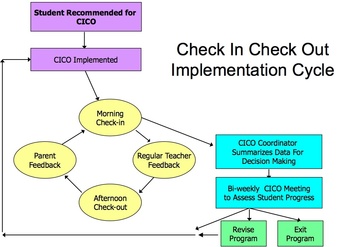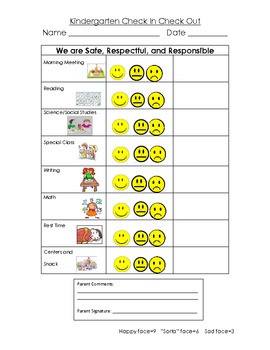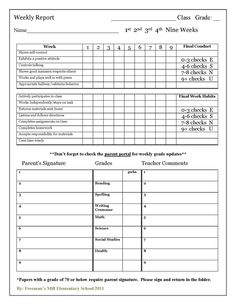Check-In-Check-Out
The goal of the Check In Check Out behavioral strategy is to prevent students who are acting out to increase these behaviors and to provide them with expectation and feedback on their behavior to prevent future problem behavior.
|
Definition/Description: The Check In-Check Out(CICO) strategies is focus on improving students classroom behaviors through motivation. The student is working on 3-4 target behaviors in which the teacher chooses and believes the student needs to work on. He or she works on those skills and if at the end of the day/lesson/class they accomplish those behaviors as assessed on their behavioral report card, then the student gets the reward/ incentive.
|
|
Justification: "Students can be motivated to improve classroom behaviors if they have both a clear road-map of the teacher's behavioral expectations and incentives to work toward those behavioral goals" (Intervention Central, 2015). The students are receiving specific skills and behaviors that the teacher want him/her to work on. Therefor the student knows exactly what the teacher expects him or her to be doing to show appropriate classroom behavior. "A balance of behavioral control and academic instruction is required..."(Hallahan, Kauffman, and Pullen, 2015). This statement from the the text means that students need to be able to control their behaviors in order to learn. This strategy allows a general education teacher to monitor her student(s) who have behavioral problems as well as makes the student(s) monitor themselves. "CICO also provides a built-in system for (a) monitoring students’ progress in the program, (b) evaluating the fidelity of implementation, and (c) transitioning to a self-managed program" (Everett, Sugai, Fallon, Simonsen, and O’Keeffe, 2011). It is important in a school setting for teacher to find behavioral interventions that work for individual students as well as whole groups (Dart, Cook, Collins, Gresham, and Chenier, 2012).
|
In this video, CICO is compare to losing weight and weight watchers. It describes how behaviors can be as hard for students as losing weight is for adults.
|
Preparation for teacher:
- Choose 3 to 4 targeted behaviors that are stated positively for student to work on.
- Creates a Behavior Report Card (rating scale anout students behabior throughout the day/class) that incorporates the 3-4 target behaviors.
- Choose a daily reward/incentive that the student will earn if he/she completes the positive behaviors
- Sets a minimum rating on the behavior report card that the student must get to earn reward/incentive
- Meet with the student to explain the intervention, review behavioral expectations, demonstrate how the Behavior Report Card is used, and explain how the student can earn a daily reward/incentive.
|
Steps:
|
This video demonstrate how the CICO can be used as a school wide tier ll PBIS intervention for students.
|
|
Example of a sheet used to keep track of student behaviors for the CICO strategy!
|
Individual Student:
"Nigel is very bright and has no problems academically. He does not initiate contact with peers and, when they initiate contact with him, he curses, yells, spits, and shoves chairs at them." (The IRS Center, 2015). He likes to be by himself. Since this student has some behaviors that are serious or harmful to others it is important to have an intervention for behavior in plan. The check in-check out stratagem allows this students to focus on just a few of him behaviors at a time. His behaviors and lack of wanting to do group work are effecting his learning. If he works on social skills for example one day he is working on saying hi to 3 friends, not hitting, and speaking in class at least twice.These are all key skills and behaviors that will help him be successful in the future and work on his social issue of not wanting to be with others. Nigel will be in charge of his rewards and if he does something that he inst supposed to, such as hit someone, he knows he has lost his reward for the day, but he always has tomorrow to change it around. This is also nice since he has many behaviors that only 3 are targeted in the time frame so he can really focus on those behaviors. |
|
Who does this strategy work for?
This intervention works for students who are in need to improve behavior, for student struggling with socal aspect, and students who need extra motivation for listen or doing work (staying on track). Picture Example: To the right is another example of a behavior report card used to track and score student behavior throughout the day. |
Content Area:
Since this strategy is used to help student improve behavioral it can be used in any subject and for any content area. There is no different in math as their is in reading for behavior. In both subjects students are held to a certain expectation of how he or she should act or shouldn't act.
Since this strategy is used to help student improve behavioral it can be used in any subject and for any content area. There is no different in math as their is in reading for behavior. In both subjects students are held to a certain expectation of how he or she should act or shouldn't act.
References:
Bartkoski, A. (2012). Behavior Chart Check In Check Out. [image] Retrieved form https://www.teacherspayteachers.com/Product/Behavior-Chart-Check-In-Check-Out-277336
Dart, E. H., Cook, C. R., Collins, T. A., Gresham, F. M., & Chenier, J. S. (2012). Test driving interventions to increase treatment integrity and student outcomes. School Psychology Review, 41, 467-481.
Everett, S., Sugai, G., Fallon, L., Simonsen, B., and O’Keeffe, B. (2011). School-Wide Tier II Interventions: Check-In Check-Out Getting Started Workbook. Retrieved form http://www.pbis.org/common/cms/files/pbisresources/8APBS_Tier2_GettingStartedWorkbook.pdf
Functional Behavioral Assessment: Identifying the Reasons for Problem Behavior and Developing a Behavior (2015). The IRS Center. Retrieved from Planhttp://iris.peabody.vanderbilt.edu/module/fba/cr_assess/#content
Hallahan, D. P., Kauffman, J. M., & Pullen, P. C. (2015). Exceptional learners: An introduction to special education. Boston, MA: Pearson/Allyn & Bacon.
How To: Manage Problem Behaviors: Check-In/Check-Out (2015). Intervention Central. Retrieved from http://www.interventioncentral.org/node/970770
PBIS - Check-In/Check-Out, CICO, Tier 2 (2012). [web video]. Retrieved from https://www.youtube.com/watch?v=EP9mywEuaOE
PBIS: Kindergarten through Eighth Grade Check-In Check Out System (2011). [Web video]. Retrieved from https://www.youtube.com/watch?v=f8Jhy_LxWDk
Bartkoski, A. (2012). Behavior Chart Check In Check Out. [image] Retrieved form https://www.teacherspayteachers.com/Product/Behavior-Chart-Check-In-Check-Out-277336
Dart, E. H., Cook, C. R., Collins, T. A., Gresham, F. M., & Chenier, J. S. (2012). Test driving interventions to increase treatment integrity and student outcomes. School Psychology Review, 41, 467-481.
Everett, S., Sugai, G., Fallon, L., Simonsen, B., and O’Keeffe, B. (2011). School-Wide Tier II Interventions: Check-In Check-Out Getting Started Workbook. Retrieved form http://www.pbis.org/common/cms/files/pbisresources/8APBS_Tier2_GettingStartedWorkbook.pdf
Functional Behavioral Assessment: Identifying the Reasons for Problem Behavior and Developing a Behavior (2015). The IRS Center. Retrieved from Planhttp://iris.peabody.vanderbilt.edu/module/fba/cr_assess/#content
Hallahan, D. P., Kauffman, J. M., & Pullen, P. C. (2015). Exceptional learners: An introduction to special education. Boston, MA: Pearson/Allyn & Bacon.
How To: Manage Problem Behaviors: Check-In/Check-Out (2015). Intervention Central. Retrieved from http://www.interventioncentral.org/node/970770
PBIS - Check-In/Check-Out, CICO, Tier 2 (2012). [web video]. Retrieved from https://www.youtube.com/watch?v=EP9mywEuaOE
PBIS: Kindergarten through Eighth Grade Check-In Check Out System (2011). [Web video]. Retrieved from https://www.youtube.com/watch?v=f8Jhy_LxWDk



